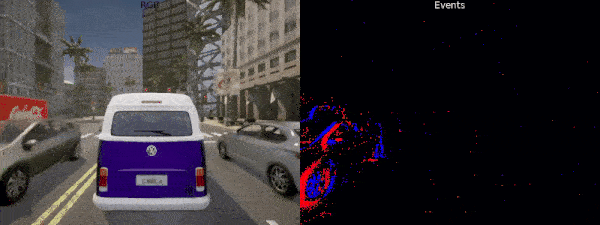rpg_e2depth

This is the code for the paper Learning Monocular Dense Depth from Events by Javier Hidalgo-Carrió, Daniel Gehrig, and Davide Scaramuzza:
You can find a pdf of the paper here. If you use any of this code or our event camera plugin in CARLA, please cite the following publication:
@Article{Hidalgo20threedv,
author = {Javier Hidalgo-Carrio, Daniel Gehrig and Davide Scaramuzza},
title = {Learning Monocular Dense Depth from Events},
journal = {{IEEE} International Conference on 3D Vision.(3DV)},
url = {http://rpg.ifi.uzh.ch/docs/3DV20_Hidalgo.pdf},
year = 2020
}
Install
Dependencies:
- PyTorch >= 1.0
- NumPy
- OpenCV
- Matplotlib
Install with Anaconda
The installation requires Anaconda3.
You can create a new Anaconda environment with the required dependencies as
follows (make sure to adapt the CUDA toolkit version according to your setup):
conda create -n E2DEPTH
conda activate E2DEPTH
conda install pytorch torchvision cudatoolkit=10.0 -c pytorch
conda install -c conda-forge opencv
conda install -c conda-forge matplotlib
Run
- Download the pretrained model:
wget "http://rpg.ifi.uzh.ch/data/E2DEPTH/models/E2DEPTH_si_grad_loss_mixed.pth.tar" -O pretrained/E2DEPTH_si_grad_loss_mixed.pth.tar
- Download the test sequence in the DENSE dataset:
wget "http://rpg.ifi.uzh.ch/data/E2DEPTH/dataset/test_sequence_00_town10.zip" -O data/test_sequence_00_town10.zip
- Extract the data sequence:
unzip -q data/test_sequence_00_town10.zip -d data/test
Before running the depth prediction, make sure the conda environment is sourced:
conda activate E2DEPTH
- Run reconstruction:
python run_depth.py -c pretrained/E2DEPTH_si_grad_loss_mixed.pth.tar \
-i data/test/events/voxels \
--output_folder /tmp \
--save_numpy \
--show_event \
--display \
--save_inv_log \
--save_color_map
Parameters
Below is a description of the most important parameters:
Main parameters
Output parameters
--output_folder: path of the output folder. If not set, the image reconstructions will not be saved to disk.--dataset_name: name of the output folder directory (default: 'reconstruction').
Display parameters
--display(default: False): display the video reconstruction in real-time in an OpenCV window.--show_events(default: False): show the input events side-by-side with the reconstruction. If--output_folderis set, the previews will also be saved to disk in/path/to/output/folder/events.--save_inv_log(default: False): compute (and then save) the inverse depth log instead of the depth log (default).--save_color_map(default: False): use color conding to display depth. It uses matplotlib 'magma' color map. Grayscale depth otherwise.
Display window
You can select between direct or inverse depth, log or lineal, and grayscale or color visualization.

DENSE dataset
We provide Depth Estimation oN Synthetic Events (DENSE) Dataset that you can use to train your model.
Event Camera plugin
You can extend DENSE or create your own dataset using our
Event camera plugin. You can have a look here for a detailed
documentation.




